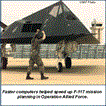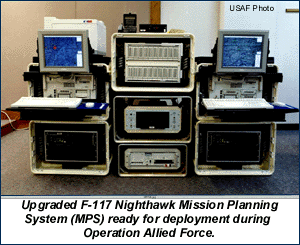F-117 Mission-Planning System Received "Emergency Upgrade" During Kosovo


The problem was the slow speed of a critical ground-based, mission-planning system that permits flight crews to develop the most "survivable" routes to and from assigned targets.
This type of mission planning for the stealthy F-117 Nighthawk is an intricate process, says First Lt. Serena Mosley-Day, a public affairs officer at the Aeronautical Systems Center at Wright-Patterson AFB. Flight crews use a powerful computer system that stores detailed information about the location of enemy aircraft, enemy bases, surface-to-air missiles and anti-aircraft artillery sites, enemy radar and other essential information. This data is then loaded into the aircraft's navigational computers and other avionics using what amounts to a ruggedized hard disk.
Units from the 49th Fighter Wing, deployed in support of Allied Force at Spangdahlem Air Base, Germany and Aviano Air Base, Italy, were using a system called the MPS, one part of the U.S. Air Force's Mission Support System (AFMSS).
The MPS "suite" consists of three "highly modified" Sun Sparc 10 minicomputers, networked together in a client-server configuration and housed in a mobile van. In Operation Allied Force, each squadron had two suites for a total of six individual workstations where electronic warfare officers could individually plan mission scenarios.

While the Air Force would not disclose how many air crews or aircraft these six workstations had to support, apparently in the heat of battle the speed of the network was too slow or number of sorties was much higher than anticipated.
"Let's just say there was a requirement for additional speed" during Operation Allied Force, David Berrett, the F-117 MPS project officer based at Wright-Patterson, told Aerospace Online.
The solution was to go to a B-2 bomber training squadron and "borrow" pieces of its mission-planning equipment, also part of AFMSS and more or less compatible with the F-117 system. That hardware included Sun Ultra Sparc 2 workstations, which were substituted as F-117 system's network servers. The result, after "slight changes to the operating system," was a nearly three-fold increase in the speed, the Air Force reported.
Decreasing the threat to the aircraft and the pilots is of primary concern, Berrett said. "We kind of like our pilots; we want them back," he said last August when the MPS system was first introduced to F-117 squadrons.
In addition to service personnel involved, the Air Force credited Lockheed Martin's Skunk Works, the F-117 prime contractor; Marconi Integrated Systems (San Diego, CA), the F-117 MPS prime contractor; and Boeing (Wichita, KS), the B-2 mission planning contractor, for the successful upgrade and testing of the new computers.
